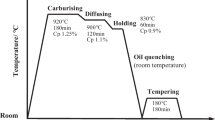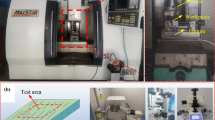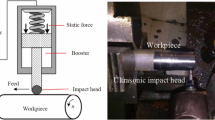Abstract
In order to explore the influence of cutting process (CP) pretreatment on surface integrity in ultrasonic rolling process (URP), we build a composite cutting–ultrasonic rolling process (CURP) model of 7N01 aluminum alloy based on finite element (FE) software and obtain the deformation mechanism of surface material in CURP treatment through plane ultrasonic rolling experiments. The results show that under CP pretreatment at different feed rates, after URP treatment, surface roughness is reduced by more than 70% compared to after CP treatment; after CURP treatment, surface roughness increases with increasing feed rate; maximum surface microhardness reaches 185 HV, and hardened depth rises to 500 μm. Cutting depth makes the greatest difference to residual stress in CURP; both the amount and depth of residual stress increase with increasing cutting depth; when the cutting depth is 0.6 mm, the residual stress after CURP treatment reaches – 350 MPa. FE analysis reveals that during URP, the surface micro-elements will pass through three deformation zones—extrusion, impact, and recovery. The coupling of mechanical stress and thermal stress will turn the residual tensile stress caused by CP treatment into a compressive stress.













Similar content being viewed by others
Data availability
The authors confirm that the data supporting the findings of this study are available within the article and/or its supplementary materials.
Code availability
Not applicable.
References
Li HX, Bai QL, Li Y, Du Q, Katgerman L, Zhang JS, Zhuang LZ (2017) Mechanical properties and cold cracking evaluations of four 7××× series aluminum alloys using a newly developed index. Mater Sci Eng, A 698:230–237
Lin HQ, Ling-Ying YE, Sun L, Xiao T, Zhang XM (2018) Effect of three-step homogenization on microstructure and properties of 7N01 aluminum alloys. Trans Nonferrous Met Soc China 28(5):829–838
Zhang ZH, Xiong BQ, Liu SF, Zhu BH, Zuo YT (2014) Changes of microstructure of different quench sensitivity 7,000 aluminum alloy after end quenching. Rare Met 33(003):270–275
Ikenaga K, Yanagida A, Azushima A (2009) New measurement method for adhesion of hard coating film. J Solid Mech 3(2):347–357
Nouri S, Rastegari S, Mirdamadi S, Hadavi M (2014) Microstructure and oxidation resistance of Si modified aluminide coating on TiAl based alloys. Surf Eng 31(12):930–933
Liu Y, Wang L, Wang D (2011) Finite element modeling of ultrasonic surface rolling process. J Mater Process Technol 211(12):2106–2113
Mao M, Zhang X, Tu S, Xuan F (2015) Prediction of crack initiation life due to corrosion pits. J Aircr 51(3):805–810
Miao HY, Demers D, Larose S, Perron C, Lévesque M (2010) Experimental study of shot peening and stress peen forming. J Mater ProcessTech 210(15):2089–2102
Roland T, Retraint D, Lu K, Lu J (2006) Fatigue life improvement through surface nanostructuring of stainless steel by means of surface mechanical attrition treatment. Scripta Mater 54(11):1949–1954
Yang YY, Fang HS, Huang WG (1996) A study on wear resistance of the white layer. Tribol Int 29(5):425–428
Deng WJ, Xia W, Li Y, Wan ZP, Tang Y (2008) Large plastic deformation and ultra-fine grained structures generated by machining. Key Eng Mater 375:21–25
Pusavec F, Hamdi H, Kopac J, Jawahir IS (2011) Surface integrity in cryogenic machining of nickel based alloy—Inconel 718. J Mater Process Tech 211(4):773–783
Teimouri R, Amini S, Bami AB (2018) Evaluation of optimized surface properties and residual stress in ultrasonic assisted ball burnishing of AA6061-T6. Measurement 116:129–139
Liu Y, Xue G, Zhao X (2017) Strain-induced gradient crystalline evolution mechanism of Ti-6.5Al-3.5Mo-1.5Zr-0.3Si during ultrasonic impacting and rolling process. Micro Nano Lett 12(5):304–307
Zhao X, Xue G, Liu Y (2017) Gradient crystalline structure induced by ultrasonic impacting and rolling and its effect on fatigue behavior of TC11 titanium alloy. Results in Phys 7:1845–1851
Tomczyk A, Seweryn A, Gra˛dzka-Dahlke M, (2018) The effect of dynamic recrystallization on monotonic and cyclic behaviour of Al-Cu-Mg alloy. Materials 11(6):874
Zhou XG, Chen QY, Liu ZY, Wu SW (2018) Dynamic recrystallization behaviors of Ti micro-alloyed 510L steel for automobile frame. Dongbei Daxue Xuebao/Journal of Northeastern University 39(5):624–629
Golshani A, Sun W, Sun K (2019) Real-time optimized load recovery considering frequency constraints. IEEE Trans Power Syst PP(99):1–1
Johnson RT (2014) A study of the effects of the cobalt transformation on the dislocation structure of cobalt whiskers using a high resolution X-ray diffraction technique. Ajp Regulatory Integrative & Comparative Physiology 307(4):310–314
Song B, Xin RL, Guo N, Liu TT, Yang QS (2014) Research progress of strain hardening behavior at room temperature in wrought magnesium alloys. Chin J Nonferrous Met 24(11):2699–2710
Grechnikov FV, Erisov YA, Surudin SV, Oglodkov MS (2018) Investigation into the formation of texture, microstructure, and anisotropy of properties during rolling sheets of the aluminum–lithium 1420 alloy. Russ J Non-Ferr Met 59(1):56–61
Zhang P, Cao X, Zhang X, Wang Y (2020) Machinability and cutting force modeling of 7055 aluminum alloy with wide temperature range based on dry cutting. Int J Adv Manuf Technol 111(9–10):1–22
Zhang P, Zhang X, Cao X, Yu X,Wang Y (2021) Analysis on the tool wear behavior of 7050-T7451 aluminum alloy under ultrasonic elliptical vibration cutting. Wear 466–467:203538
Zhang P, Zhang X, Yu X,Wang Y (2020) Research on the nanocutting mechanism of Ni-Fe-Cr-based superalloys: conventional cutting versus UEVC. Mater Today Commun 26(11):101795
Brock LM, Georgiadis HG (2007) Multiple-zone sliding contact with friction on an anisotropic thermoelastic half-space. Int J Solids Struct 44(9):2820–2836
Duan C, Zhang L (2013) A reliable method for predicting serrated chip formation in high-speed cutting: analysis and experimental verification. Int J Adv Manuf Technol 64(9–12):1587–1597
Liu W, Zhang P, Yang X, Tang C (2015) Johnson-cook constitutive model for 7055 aluminum alloy based on reverse method. Ordnance Mater Sci Eng 4:5–9
Ni C, Zhu L, Liu C, Yang Z (2018) Analytical modeling of tool-workpiece contact rate and experimental study in ultrasonic vibration-assisted milling of Ti-6Al-4V. Int J Mech Sci 142–143:97–111
Ni C, Zhu L(2020) Investigation on machining characteristics of TC4 alloy by simultaneous application of ultrasonic vibration assisted milling (UVAM) and economical-environmental MQL technology - ScienceDirect. J Mater Process Technol 278
Yang XW, Zhu JC, Lai ZH, Liu Y, He D, Nong ZS (2013) Finite element analysis of quenching temperature field, residual stress and distortion in A357 aluminum alloy large complicated thin-wall workpieces. Trans Nonferrous Met Soc 23(6):1751–1760
Thambiratnam G (2004) A numerical study on the impact response and energy absorption of tapered thin-walled tubes. Int J Mech Sci 46:201–216
Ovri H, Lilleodden ET (2019) On the estimation of thermal activation parameters for Portevin–Le Chatelier effect from nanoindentation data. JOM 71(10):3343–3349
Sabelkin V, Martinez S, Mall S, Sathish S, Blodgett M (2005) Effects of shot-peening intensity on fretting fatigue crack-initiation behaviour of Ti-6Al-4V. Fatigue Fract Eng Mater Struct 28(3):321–332
Bhushan B (1996) Contact mechanics of rough surfaces in tribology: single asperity contact. Appl Mech Rev 49(5):1–35
Coules HE, Horne G, Kabra S, Colegrove P, Smith DJ (2017) Three-dimensional mapping of the residual stress field in a locally rolled aluminium alloy specimen. J Manuf Process 26:240–251
Tsai MY, Chang SY, Hung JP, Wang CC (2016) Investigation of milling cutting forces and cutting coefficient for aluminum 6060–T6. Comput Electr Eng 51(4):320–330
Funding
This study was funded by the National Natural Science Foundation of China (NO.51575289), the Key Research and Development Project of Shandong Province (No. 2019GHY112068), and the Natural Science Foundation of Shandong Province (NO. ZR2019PEE028).
Author information
Authors and Affiliations
Contributions
The first author Xiao Yu has been responsible for writing this paper, drawing up the experimental scheme, establishing the finite element model, and analyzing all the obtained raw data. The corresponding author Youqiang Wang directed the analysis of experiment and simulation data. Ping Zhang was mainly responsible for the residual stress test in this paper. Xuezhao Wang and Xiujie Yue assisted in CURP processing.
Corresponding author
Ethics declarations
Ethics approval
This paper does not contain any data collected from human or animal experimenters, or other experiments requiring ethical approval. All work compliance with ethical standards.
Consent to participate
All participants were voluntary and agreed to participate in the study.
Consent for publication
All the authors agreed that this article be published in The International Journal of Advanced Manufacturing Technology.
Conflict of interest
The authors declare no competing interests.
Additional information
Publisher's Note
Springer Nature remains neutral with regard to jurisdictional claims in published maps and institutional affiliations.
Rights and permissions
About this article
Cite this article
Yu, X., Wang, Y., Zhang, P. et al. Surface integrity of high strength aviation aluminum alloy in CURP treatment. Int J Adv Manuf Technol 119, 6135–6146 (2022). https://doi.org/10.1007/s00170-021-08499-w
Received:
Accepted:
Published:
Issue Date:
DOI: https://doi.org/10.1007/s00170-021-08499-w




